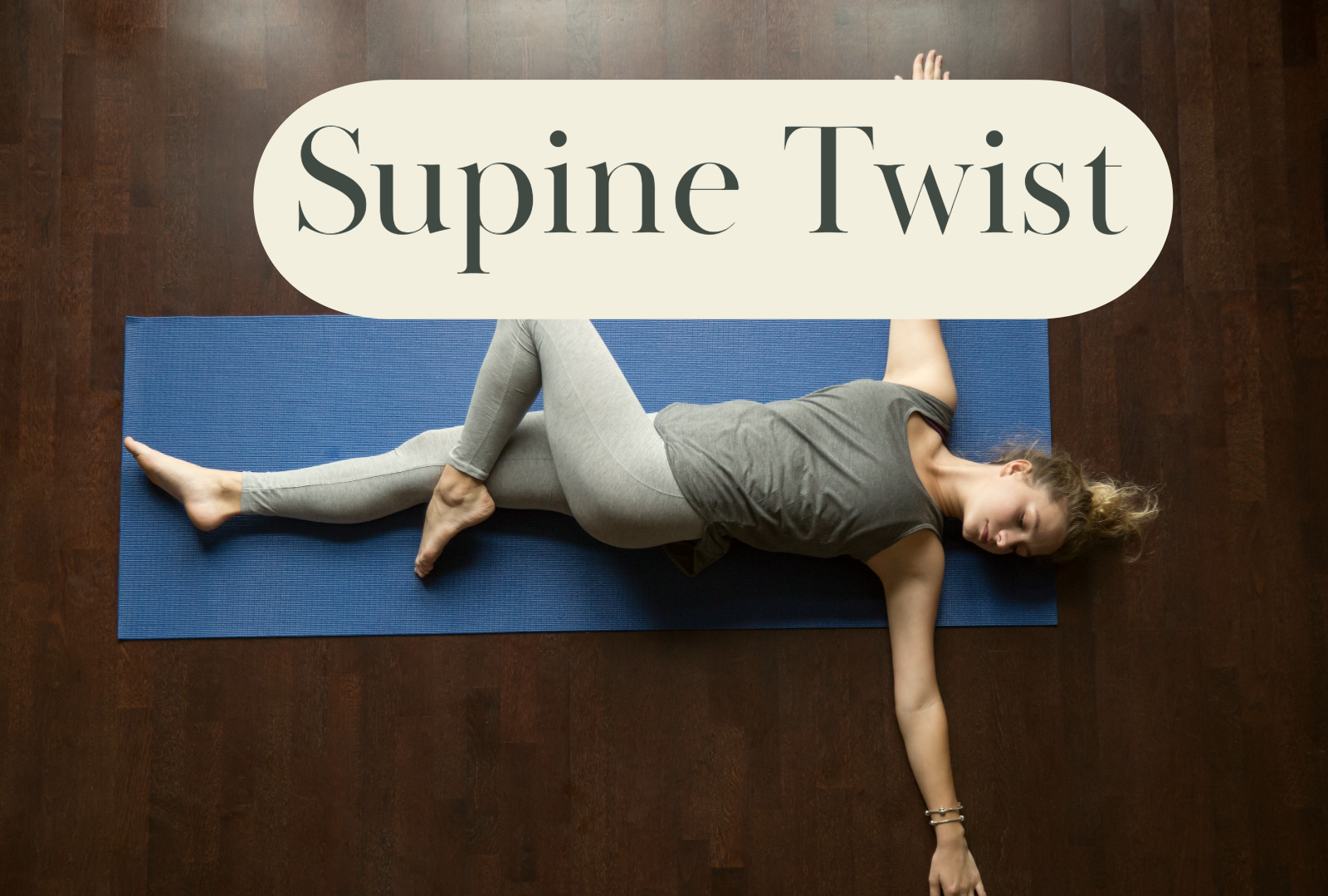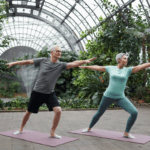Coming Soon: E-book about Kundalini Yoga - Sign up here to be among the first to get it!
Sanskrit: Supta Matsyendrasana II
Type: Supine Pose, Twist Pose
Chakra Involved: Crown Chakra (Sahasrara Chakra), Root Chakra (Muladhara Chakra)

Supine Spinal Twist Pose II (Supta Matsyendrasana II)
Supine Spinal Twist Pose II, or Supta Matsyendrasana II, is a gentle yet effective yoga pose that stretches the spine and muscles of the back. This restorative twist aids in releasing tension in the lower back, stretching the glutes, and encouraging mobility and flexibility in the spine. Additionally, it stimulates the digestive organs, helping to improve digestion. This pose is often included towards the end of a yoga practice as it helps to relax the body and prepare for Savasana.
Starting Position
Begin by lying flat on your back on a comfortable, flat surface, with your legs extended straight out and your arms resting by your sides, palms facing down.
Step-by-step Instruction
- Bend Your Knees: Draw both knees towards your chest, keeping your back flat on the ground. Allow your knees to touch and your feet to lift off the floor.
- Extend Your Arms: Stretch your arms out to the sides in line with your shoulders, palms facing down, to form a T-shape with your body.
- Start the Twist: Exhale slowly and lower your knees to the right side, keeping them stacked and bending at the hips. Allow your left shoulder to lift slightly if needed but try to keep both shoulders grounded.
- Adjust Your Gaze: Turn your head to the left, bringing your gaze over your left shoulder, enhancing the spinal twist. Ensure your neck is comfortable, and adjust your gaze as needed.
- Deepen the Stretch: Place your right hand gently on your left knee to encourage a deeper twist, if comfortable. Keep your left arm extended, and focus on relaxing into the pose with each exhale.
- Hold the Pose: Stay in this position for 30 seconds to a minute, breathing deeply and allowing the twist to gently stretch your spine and muscles.
To Release the Pose
- Return Your Knees: Inhale and gently bring your knees back to center, hugging them towards your chest for a moment to neutralize your spine.
- Switch Sides: When ready, repeat the twist on the opposite side to ensure a balanced stretch.
- Final Relaxation: After completing the twist on both sides, extend your legs and arms to relax in Savasana for a few moments.
Teacher’s Tip
- Engage Your Core: Encourage students to engage their abdominal muscles as they bring their knees back to center to support the lower back and maintain control.
- Respect Your Limits: Remind students to listen to their bodies and only twist as far as comfortable, avoiding forcing the stretch.
- Use Props for Support: Suggest placing a cushion or folded blanket under the knees or between the knees for those who need extra support or have difficulty keeping their shoulders grounded.
- Focus on Breath: Guide students to use their breath to deepen into the twist, inhaling to prepare and exhaling to gently deepen the stretch, promoting relaxation and release throughout the pose.
Supine Spinal Twist Pose II offers a gentle way to conclude a yoga session, providing both physical and mental relaxation. It’s a simple yet powerful pose suitable for practitioners of all levels.
Variations of Supine Spinal Twist Pose II (Supta Matsyendrasana II)
The Supine Spinal Twist II, or Supta Matsyendrasana II, is a rejuvenating pose that stretches the back muscles and spine, promoting flexibility and stimulating the digestive organs. Here are some variations of Supta Matsyendrasana II, along with instructions for each, to accommodate different levels of flexibility and focus on specific benefits.
1. Knee-to-Chest Variation
- Instructions: Begin in the starting position of Supta Matsyendrasana II. Instead of extending both legs across the body, extend the right leg down and bent the left leg over the right side. This pose is called Supine Spinal Twist Yoga Pose I. Switch side. This variation offers a deeper twist, suitable for a deeper stretch of the lower back and the shoulders.
2. Extended Arm Variation
- Instructions: While in the twist, extend your arms out to the sides in a T-shape, palms facing up. This opens the chest and shoulders more deeply, enhancing the upper body stretch and facilitating a deeper breath.
3. Eagle-Legged Twist
- Instructions: From the starting position, cross one leg over the other as if you’re sitting cross-legged in a chair, then lower both legs to one side, keeping the cross. This intensifies the stretch on the hips and glutes, adding an extra element of balance and focus.
4. Supported Twist with Bolster
- Instructions: Place a bolster or firm pillow along your side before lowering your knees into the twist. Rest your knees on the bolster, allowing for a supported, gentler twist. This is ideal for those seeking a softer approach or for use in restorative practices.
5. Twist with Bound Legs
- Instructions: From the starting position, bind your top leg by wrapping the foot of the top leg around the calf or ankle of the bottom leg as you twist. This variation helps keep the legs engaged and together, deepening the twist and stretch.
6. Chair Twist
- Instructions: For those who cannot comfortably lie down or prefer a seated position, replicate the twist using a chair. Sit sideways on the chair, feet flat on the floor, and twist your torso toward the back of the chair, holding onto the chair back for support. This seated twist offers similar benefits to the spine and digestion.
7. Hand-to-Knee Variation
- Instructions: As you twist, reach your hand (opposite to the direction of the knees) towards the top knee to gently deepen the twist. This active engagement can help intensify the twist and stretch, promoting greater spinal mobility.
Implementation Tips
- Use Props: Encourage the use of props like bolsters, blocks, or blankets to make variations more accessible and comfortable.
- Listen to Your Body: Remind students to listen to their bodies and choose the variation that best suits their needs, avoiding any strain or discomfort.
- Focus on Breath: Regardless of the variation, maintain steady, deep breaths to help deepen into the twist and increase relaxation.
- Slow Transitions: Emphasize the importance of moving into and out of twists slowly and mindfully to protect the spine and allow the body to adjust.
Exploring these variations of Supta Matsyendrasana II can help practitioners experience the pose in new ways, catering to their individual needs while still receiving the benefits of spinal twisting.
FAQs About Supine Twist Pose
A Supine Spinal Twist involves lying on your back and gently rotating your spine by turning your legs to one side and your upper body to the other. This pose helps to stretch the back muscles and spine, providing a gentle massage to the spinal vertebrae and abdominal organs, promoting flexibility and stimulating digestion.
Yes, the Supine Spinal Twist is generally safe for most people when performed correctly and with awareness to one’s body limits. It’s a gentle twist that offers a controlled stretch to the spine, making it accessible to beginners and beneficial for those looking to relieve back tension. However, individuals with specific health conditions should exercise caution or consult with a healthcare provider.
Spinal twists in yoga offer multiple benefits, including:
- Improved Spinal Flexibility: Twists help increase the flexibility and range of motion in the spine.
- Stimulation of Digestion: The twisting motion massages internal organs, stimulating digestion and helping to detoxify the body.
- Relief from Back Pain: Gentle twisting can relieve tension and pain in the back.
- Enhanced Circulation: Twisting poses can enhance blood circulation, bringing fresh oxygen and nutrients to the spinal area and internal organs.
- Stress Reduction: The act of twisting and releasing can help reduce physical and mental stress.
The lying spinal twist specifically helps to:
- Relax the Body: Being performed in a lying position, it allows for greater relaxation and ease in the twist.
- Gently Stretch the Back: Provides a gentle stretch that is accessible and soothing for the back muscles.
- Stimulate Internal Organs: Like other twists, it massages the internal organs, promoting better digestion and detoxification.
In a gentle practice or restorative yoga, you might hold a spinal twist for several minutes, focusing on deep relaxation. In a more dynamic practice, holding the pose for 5 to 30 seconds can be sufficient to feel its benefits. Always listen to your body and adjust the duration according to your comfort and the intention of your practice.
- Lengthen First: Before twisting, it’s important to lengthen the spine upwards to create space between the vertebrae, allowing for a deeper and safer twist.
- Twist from the Bottom Up: Begin your twist from the base of your spine, gradually moving up to the middle and then the upper back, ensuring an even twist that respects the natural movement of the spine.
- Breathe: Breathing is crucial in twists; inhale to find length, and exhale to deepen into the twist. Proper breathing helps facilitate movement and increases the benefits of the twist.
Individuals with the following conditions should exercise caution or avoid supine twists:
- Spinal Injuries or Conditions: Those with significant spinal issues or recent back surgery should consult with a healthcare provider.
- Pregnancy: Pregnant women, especially in the later stages, should modify or avoid deep twists to prevent discomfort and pressure on the abdomen.
- Severe Osteoporosis: Individuals with severe osteoporosis or a risk of bone fractures should avoid forceful twists.
- Herniated Disks: Those with herniated disks should proceed with caution, as twisting could aggravate the condition.
Consultation with a healthcare provider is recommended for anyone with health concerns before practicing twists or any new yoga poses.




